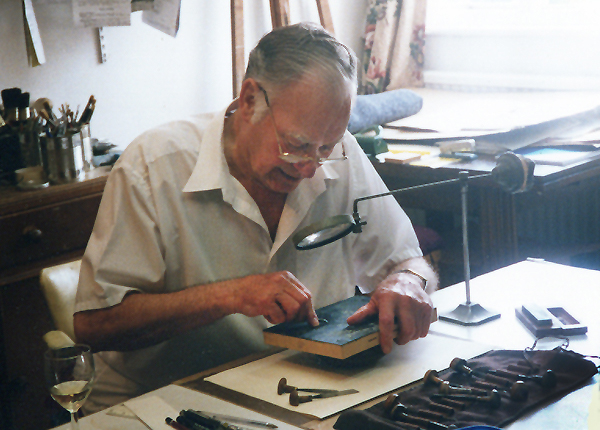
INTRODUCTION by Hilary Chapman,of Hilary Chapman FIne Prints.
For over thirty years James
Bostock combined an artistic career with that of a full-time teacher
and administrator. Notwithstanding his academic commitments, as well
as the inevitable demands of bringing up a family of three boys, Bostock
produced a remarkable oeuvre of paintings and prints. The process
of cataloguing the seventy or so wood engravings, as well as the intaglio
prints, lithographs and illustrative work has been a revelation (not
least to the artist himself) of the breadth of subject matter and
variety of style these prints demonstrate.
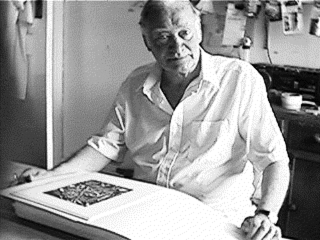
It was at the Royal College of Art in the 1930s, under the influence
of such tutors as Edward Bawden, Eric Ravilious and Paul and John
Nash that Bostock first became attracted to printmaking, and especially
wood engraving. After distinguished war service he began to produce
wood engravings which were soon recognised fortheir fine craftsmanship
and artistic individuality. By 1950 he had been elected a member of
both the Royal Society of Painter-Etchers and Engravers (later the
Royal Society of Painter-Printmakers) and the Society of Wood Engravers.
He exhibited regularly at the annual exhibitions of these societies
and his work was often included in the Royal Academy summer shows.
Museums and international institutions acquired his wood engravings
and Bostock quietly secured his position within the print world. There is a collection of prints by James Bostock in the Victoria and Albert Museum, London which can be viewed on this link.
However, it was not until retirement in 1978, and a resultant flurry
of artistic activity, that James Bostock's work came before a wider
audience. Exhibitions of his paintings and prints occurred regularly
and the wood engravings were shown at the exhibitions of the newly
invigorated Society of Wood Engravers, which was now fostering a growing
interest in the medium. Bostock was able to promote not only his many
earlier works, but also the results of a productive decade. Sadly,
by 1988, deteriorating eyesight and the onset of arthritis caused
him to cease wood engraving - although, even then, he still painted
and drew with vigour.
The wood engravings continued to be shown at exhibitions and, in 1996,
Bostock was one of nineteen major artists to be included in an exhibition
arranged by Hilary Paynter (Chairman of the Society of Wood Engravers)
at the Bankside Gallery, London. This exhibition featured artists
who were members of both The Royal Society of Painter-Printmakers
and the Society of Wood Engravers. Bostock had no impressions left
of his most popular prints and Hilary Paynter kindly offered to print
some of these blocks for him. She is full of admiration for the deep
cutting and quality of the artist's blocks and described them as 'a
joy to print'.
Only a year later Bostock's work was included in Hal Bishop's landmark
exhibition at Exeter Museum, Twentieth-Century British Wood Engraving:
A Celebration... and a Dissenting Voice. This exhibition received
an Arts Council award and is possibly the most important display of
British wood engraving to occur in recent years. James Bostock acknowledged
fulsomely the generosity and genuine interest that Hal Bishop has
shown in promoting his work Indeed a solo exhibition of Bostock's
watercolours and prints was curated by Hal Bishop at Exeter Museum
in the Following year In order to show the full range of his artistic
output.
A substantial and distinguished group of collectors has now been established
to James Bostock's wood engravings who admire not only the technical
skill of his prints but their humour, observation and stylistic variety.
This catalogue has been produced to record and reproduce these prints.
It could not have been completed without the artist's generous help
and kindly co-operation which has been much appreciated.
- Hilary
Chapman. November 2002.
The artist adds:
‘I
owe an enormous debt to Gwladys Irene, my wife for sixty two years
for maintaining a comfortable home, bringing up three excellent
sons, and helping me constantly with all the practical problems
of my work, purchasing materials etc. and often making perceptive
comments on design questions. Without her constant help I could
only have produced only a small fraction of my work'
A footnote from the Bostock Family
We owe an enormous debt of gratitude to Hilary Chapman, originally the proprieter of the 29th Century Gallery, Kings Road, Chelsea,
who for many years acted as agent to James Bostock in making it possible to bring his wood engravings to the attention of a wider public with an interest in this medium.
Hilary has been active in this role for well over a thirty year period and only recently in 2020 decided to retire from an active role in representing artists and engravers.
The sons of James Bostock, who are now guardians of his work and his legacy, offer their heartfelt thanks to Hilary for all that she has done to support our father and provide an outlet for his work, We wish Hilary a long and happy retirement.
Wikipedia
For further details about the life and work of James Bostock, please see the Wikipedia page: https://en.wikipedia.org/wiki/James_Bostock_(painter)
FOREWORD by Simon Brett, former Chairman of the Society of Wood Engravers
The immediacy of James Bostock's
wood engravings makes time collapse, yet they are also rooted in the
decades in which they were produced. In this most welcome catalogue
we can reconcile the vivid impact of his art, the rather different
sense of time we carry within us, and the actual chronology which
Hilary Chapman has so valuably researched
.
Though only one print dates from the nineteen-thirties, Bostock's
work first seems to speak to us with the accent of that decade, which
is only natural. In common with many others, his career suffered the
major interruption of the Second World War, which took six years of
his life just where his education finished and his mature development
should have begun. He picked up after it, therefore, with styles and
attitudes formed before it.
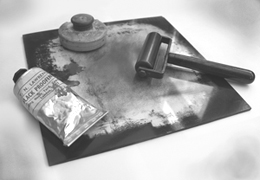
By the nineteen-fifties, however, his essays in Hayteresque modernism
were completely up-to-the-minute; and the social scene depicted in
'Train Coming' and 'Greengrocers' is also perfectly true to the decade
- my childhood - though it feels so much longer ago now. Our memories
play us tricks. These prints remind us how much art was still in 'post-war
mode' not only throughout the 'fifties but well into the 'sixties.
They speak from before the watershed of that later period. After it,
neither art nor the place of wood engraving within it, was quite the
same, but the change did not really happen until late in the decade.
James Bostock was fifty then, and well established in his manner of
working; but, just at that point, he became so busy with teaching
that it caused a second interruption in the production of his prints.
So the correspondence between Ducks in the Wood of 1946 and Black
Park I of 1960 should not surprise us. Those virtuoso engravings Brentford
Lock and The Mirror, with their Hayteresque swirls, demonstrate, as
they must have done to the artist at the time, that there was every
bit as much rhythm in his more naturalistic landscapes. When he picked
up his burin afresh in the early nineteen-eighties, after retiring
from teaching and administration, it is right that it was in a different
mode and spirit again. What wetter waves have ever broken onto paper!
Considerable tonal risks are taken in Positano and Near Ullswater,
made of shifting greys rather than the bold blacks and whites of earlier
years. These prints impose less on nature. They have a touching awe
before it. Yet across fifty years there is an immediately recognisable
consistency; the work of a long life united by a vivid and ebullient
enthusiasm for the things seen.
Editions
James Bostock chose to print small editions by hand burnishing, normally
about 30 or 40 impressions. Some blocks that were experimental, or
to be used commercially, were not editioned. About five to ten proofs
were printed from these blocks, they were usually signed.
In some cases where demand was high, Bostock printed a further 10
to 30 impressions from the block as a second, and sometimes a third,
edition. However, the editions rarely amount to more than 60 impressions
in total.
In 1996/1997 Hilary Paynter printed impressions from several of James
Bostock's blocks on her Albion press. (Three of the blocks were printed
by Vitaly Moiseev under Hilary Paynter's supervision.) These prints
were also included as part of second or third editions and are identified
in the catalogue.
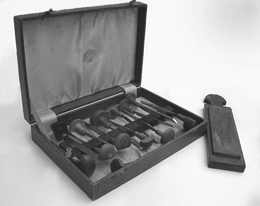
Papers
All editions printed by Bostock are on Japanese paper or Basingwerk
Parchment. Editions printed by Hilary Paynter are on Zerkall (ENE
III).
Blocks
Bostock was often experimental in his approach to technique. Economic
as well as innovative considerations led him to use a variety of materials
as a matrix as well as the usual boxwood, endgrain block. Where a
variation has been used this has been noted in the catalogue.
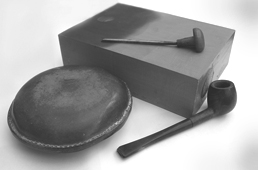
Colour
During the I 950s and 1960s Bostock experimented with colour on a
few blocks, usually by overprinting with lino blocks. Although achieving
some remarkable results and a prestigious prize (see 'The Mirror' catalogue number
27a), Bostock considered that a black and white image was always more
powerful.